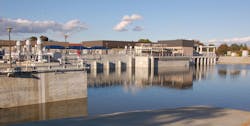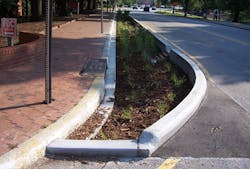Retrofit or Replace: Factors to Consider When Planning Water Infrastructure Projects
By William Atkinson
When it comes time to improve aging water, wastewater and stormwater infrastructure, new construction is always an option. However, it is often the most expensive option. Other options are retrofitting, and, in some cases, repair. However, each of the three has its pros and cons.
Dublin San Ramon Services District
When it comes to upgrading its water infrastructure, the Dublin San Ramon Services District (DSRSD; Dublin, Calif.) considers "the three R's": repair, rehabilitate, or replace. "We are a newer utility, so we haven't had to do a lot of rehabilitation or replacement of our infrastructure yet, but we will have to deal with these issues on the horizon," said Dan McIntyre, engineering services manager. "As a result, we created an asset management program and began laying out some of the criteria on how we will make the call to repair, rehabilitate or replace our assets." The District considers up to five different factors in making its decision.
1. Life-Cycle Cost
"If we have a pump that breaks down and requires frequent repairs, or operates inefficiently, we will look at the life-cycle cost," said McIntyre. First, the district looks at the annual costs associated with the repairs and inefficient operations. Second, it looks at the costs that would be associated with rehabilitating the pump, such as replacing certain components that need the most frequent repairs. "Here, we may decide to do this every ten years, instead of engaging in spot fixes every two years," he said. The third option is to consider full replacement. As the District sees it, this would make sense if the costs associated with repair or rehabilitation would be excessive. "That is, it might be less expensive over the long run to install a brand new pump, especially if it has newer more cost-effective technology and more durable components," he said. "We determine the costs of all three of these options."
2. Criticality
An example of a critical asset might be a key pump station that moves wastewater to the plant or that fills a principal water tank for the District's water system -- such as one that the District would need in the event of an emergency. There are two elements to consider here. The first is the consequence of the failure. That is, how important is the asset? "For example, if it is unacceptable for this pump station to be out of operation, we are more inclined to do a full replacement, even if it ends up being more expensive than repairs or rehabilitation," said McIntyre. The second element is the probability of failure. Is the chance of failure remote (maybe only one year in 100)? Or is the chance much more likely? "The higher the probability of failure, the more likely we are to consider replacement," he said.
3. Future Growth
The third factor to consider is whether or not there is new development coming on line that would place more demand on a facility than the existing pump can currently handle. In that case, the District would likely replace the asset and upsize it at the same time.
4. Service Improvements
A fourth consideration comes into play if the District needs to improve the level of service. "For example, if there are some new environmental regulations coming out that will require us to upgrade to new technology, such as clarifiers at our wastewater treatment plant," said McIntyre, "we are likely to engage in replacement with equipment that will meet the requirements of the new regulation."
5. Energy Efficiency
Replacing existing equipment with newer energy-efficient equipment may be more cost-effective over the life cycle of the asset than repair or rehabilitation of the existing equipment.
McIntyre shared an example of a District decision to renovate rather than replace. "We had an old reinforced concrete pipe going into our wastewater treatment plant that had been installed in the late 1950s or early 1960s and was beginning to experience corrosion," he recalled. One option was to replace that pipe with something resistant to corrosion, such as vitrified clay pipe or PVC. Another option was to leave the concrete pipe in place, and install a plastic liner or coat the inside to protect it from the sulfides.
"It ended up being more cost-effective to line it than to replace it," he said. "However, as with other projects, we didn't look at just the cost. We considered whether we might need to upsize the pipe to accommodate new development. We found that the existing pipe's size would still meet projected demands for the future." As a result, the District made the decision to install the lining instead of replacing the pipe, which ended up being about half the cost of a full replacement.
Public Works Department, City of Raleigh, NC
For the Public Works Department in Raleigh, N.C., some of its capital improvement projects involve a combination of retrofit measures, whenever feasible and cost-effective, as well as instances of completely new infrastructure. In each case, though, the department carefully considers the pros and cons of new construction and retrofit.
"New construction offers the comfort of knowing that, at project completion, the infrastructure that is left in the ground is as good as new," said Blair Hinkle, P.E., stormwater program manager. "Generally, these are open-cut projects with thorough inspections of every new pipe joint, bedding, compaction, etc. This process provides assurance that the final in-situ infrastructure is at the beginning of its useful life."
For retrofit projects, cost is generally the driver for the department. "In addition, limiting traffic and pedestrian disruption is an important benefit in some cases," said Hinkle. "Retrofits to the maximum extent practicable are sometimes necessary due to the potential impacts from more expansive new construction measures."
Each situation or area in need of improvement is evaluated to determine the optimum approach that will maximize benefits from a project while minimizing the costs and impacts to the extent possible.
In general, according to Hinkle, shallow, smaller pipes that have deteriorated significantly or are undersized are generally more efficiently replaced through the use of "remove and replace" techniques. On the other hand, deeper, larger pipes that have generally maintained their shape and structural integrity are typically good candidates for sliplining or CIPP (cured-in-place pipe).
Stormwater retrofit opportunities for the department often take one of two forms. One pertains to stormwater treatment -- the installation of water quality devices on already-developed property. The City of Raleigh has several programs to promote and assist with the installation of retrofit devices. For example on public land, such as parks, greenways and city facilities, the stormwater utility might completely fund the installation of one of these devices. On private property, the City has a cost-sharing policy that allows for City participation to a level not to exceed 75 percent of the cost of installation.
The second form relates to infrastructure repair. In the case of stormwater infrastructure, this is most commonly some sort of sliplining or CIPP to repair a degraded pipe segment. The decision here almost always comes down to cost versus benefit. "The pipe depth, size, condition, and material of construction are all taken into consideration when determining whether to dig and replace, or to slipline," said Hinkle.
The City of Oviedo, Fl
According to Josef Grusauskas, utility manager for the City of Oviedo, Fla., the City has experienced intense growth over the past decade, placing stress on the existing utility infrastructure. "To keep up with the utility demands, the City has both retrofitted existing utility systems and installed new systems," he said.
The decision to retrofit or build new infrastructure is both an opportunistic and an economic decision. "Retrofitting is opportunistic in nature because there has to be an existing infrastructure in place to retrofit," he explained. That is, new construction is typically required in situations where there is no infrastructure, or poor infrastructure, to work with.
However, if existing and adequate infrastructure is in place, then it is purely an economic decision, and retrofitting is economically more viable than new construction. "The City has found that evaluating existing infrastructure to be retrofitted is very cost effective," said Grusauskas.
While the major benefit of retrofitting is cost savings, new construction does have some benefits. For example, according to Grusauskas, new construction is typically easier to permit and build while maintaining existing utility demands. "Retrofitting existing infrastructure, on the other hand, is typically more difficult to permit, and it is more difficult to maintain existing utility demands," he said.
Recently, the City was able to retrofit an existing 20-inch raw water main that was to be taken out of service with a plant closure, and convert it into a potable water main for a cost of $1 million. A new 20-inch water main, on the other hand, was estimated to cost $2.5 million to construct. The retrofit main therefore offered significant savings.
As noted above, though, retrofitting is not without its challenges. "For example, with the City's raw-to-potable water main project, the engineer had to have several meetings with the local permitting agency to resolve non-common issues, such as pipe cleaning and testing," said Grusauskas. "In addition, the utility had to create special operating plans with the contractor to ensure that the water system had sufficient water to operate while the retrofit pipe was converted."
About the Author: William Atkinson is a correspondent for WaterWorld Magazine. He has been a full-time freelance business magazine writer since 1976, specializing in infrastructure, sustainability, supply chain, risk management, and safety/health.



